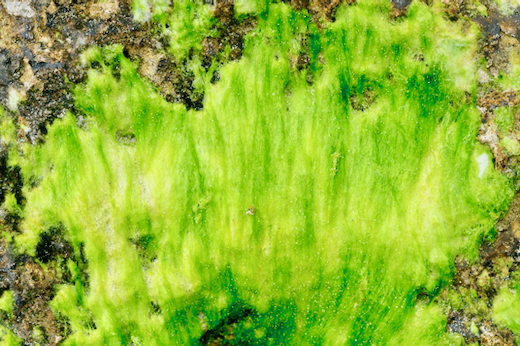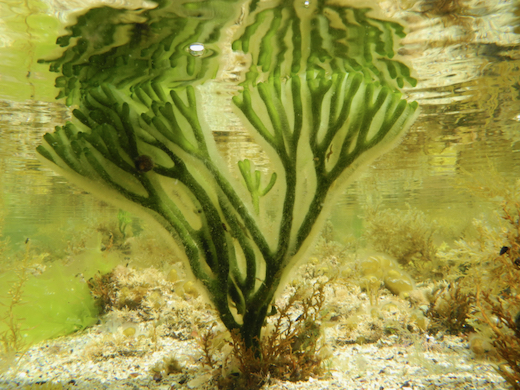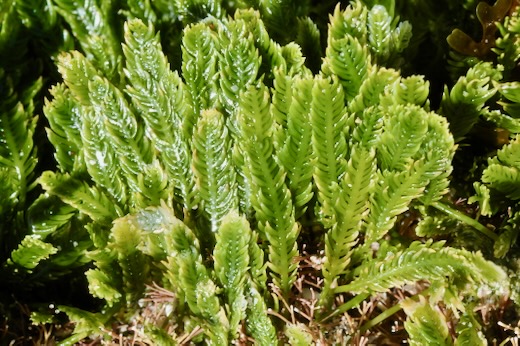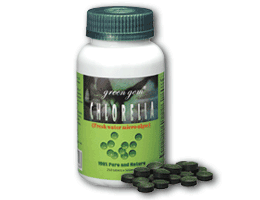Chlorophyta: Green Algae
Examples: Chlorella, Chlamydomonas, Spirogyra, Ulva. Green seaweeds
Characteristics: Green colour from chlorophyll a and b in the same proportions as the 'higher' plants; beta-carotene (a yellow pigment); and various characteristic xanthophylls (yellowish or brownish pigments). Food reserves are starch, some fats or oils like higher plants. Green algae are thought to have the progenitors of the higher green plants but there is currently some debate on this point.
Green algae may be unicellular (one cell), multicellular (many
cells), colonial (living as a loose aggregation of cells) or
coenocytic (composed of one large cell without cross-walls; the
cell may be uninucleate or multinucleate). They have
membrane-bound chloroplasts and nuclei. Most green are aquatic
and are found commonly in freshwater (mainly charophytes) and
marine habitats (mostly chlorophytes); some are terrestrial,
growing on soil, trees, or rocks (mostly trebouxiophytes). Some
are symbiotic with fungi giving lichens. Others are symbiotic
with animals, e.g. the freshwater coelentrate Hydra has a
symbiotic species of Chlorella as does
Paramecium bursaria, a protozoan. A number of
freshwater green algae (charophytes, desmids and
Spirogyra) are now included in the Charophyta
(charophytes), a phylum of predominantly freshwater and
terrestrial algae, which are more closely related to the higher
plants than the marine green algae belonging to the Chlorophyta
(known as chlorophytes). Other green algae from mostly
terrestrial habitats are included in the Trebouxiophyceae, a
class of green algae with some very unusual features.
Asexual reproduction may be by fission (splitting), budding, fragmentation or by zoospores (motile spores). Sexual reproduction is very common and may be isogamous (gametes both motile and same size); anisogamous (both motile and different sizes - female bigger) or oogamous (female non-motile and egg-like; male motile). Many green algae have an alternation of haploid and diploid phases. The haploid phases form gametangia (sexual reproductive organs) and the diploid phases form zoospores by reduction division (meiosis). Some do not have an alternation of generations, meiosis occurring in the zygote.


.jpeg)
Commercial uses: Organic beta-carotene is produced in Australia from the hypersaline (growing in high salinity water often known as brine) green alga Dunaliella salina grown in huge ponds. Carotene has been shown to be very effective in preventing some cancers, including lung cancer. Caulerpa, a marine tropical to warm-temperate genus, is very popular in aquaria. Unfortunately, this has led to the introduction of a number of Caulerpa species around the world, the best-known example being the invasive species Caulerpa taxifolia.

Chlorella, a genus of freshwater and terrestrial unicellular green alga with about 100 species, is grown like yeast in bioreactors, where it has a very rapid life history. It may be taken in the form of tablets or capsules, or added to foods such as pasta or cookies. Taken in any form, it is said improve the nutritional quality of a daily diet. According to the Taiwan Chlorella Manufacturing Company the increase in processed and refined foods in the diet of modern man make Chlorella an important food supplement for anyone interested in better health.

-
 BioAtlantis
provides sustainable technologies from the sea to enhance
plant, animal and human health.
BioAtlantis
provides sustainable technologies from the sea to enhance
plant, animal and human health.
-
 Connemara Organic Seaweed Company
provide hand harvested, sustainable, kelp and seaweed products
for human consumption through health supplements and edible
products.
Connemara Organic Seaweed Company
provide hand harvested, sustainable, kelp and seaweed products
for human consumption through health supplements and edible
products.
-
 Emerald Isle Organic Irish Seaweed.
A family business producing seaweed as supplements,
cooking, gardening and bath products.
Emerald Isle Organic Irish Seaweed.
A family business producing seaweed as supplements,
cooking, gardening and bath products.
-
 Irish Seaweeds Ltd
are suppliers of 100% natural hand-harvested seaweeds and
edible sea vegetable products from Ireland.
Irish Seaweeds Ltd
are suppliers of 100% natural hand-harvested seaweeds and
edible sea vegetable products from Ireland.
